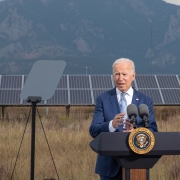Blue Today, Bluer Tomorrow
The long-rising blue tide that has colored American politics and values may have crested, but it could still have enough momentum to make it through the election year. Even if Trump is somehow reelected, the wielders of power and influence — academia, media, Wall Street, Hollywood, the big-tech oligarchs, the dominant nonprofits, and the governmental apparat — will remain deep blue for the foreseeable future.
The prospect of untrammeled progressive power, particularly with a malleable Joe Biden in the White House, may seem depressing for conservatives or even old-style liberals, who are concerned by the Left’s increasingly censorious and authoritarian bent. But there is also a silver lining of sorts. Everywhere blue policies — generally now referred to as “progressive” — have prevailed, they have failed miserably, particularly for those parts of the population, such as the working class and minorities, that they purport to serve.
Over time, these failures will open up an opportunity perhaps not for a resurgence of traditional conservatism but for a reshuffling of political loyalties away from those whose policies don’t work. Many core constituencies associated with blue politics may become aware that their interests, prominent on the progressive menu, will never in reality be served. Ultimately, results, not memes, matter most. Progressives have demonstrated monumental incompetence in addressing everything from social equity to education, culture, and energy policy. Even in postmodern America, failure cannot forever be sold as success.
The cry for greater equality, particularly for minorities, dominated the rhetoric of the 2020 Democratic National Convention. Hollywood, the corporate world, professional sports, academia, and the mainstream media are all being lured by the siren song of “social justice,” but that song sounds nice and empathetic only until you look at the results.
In analyzing the nation’s 107 largest metropolitan regions (populations over 500,000), Wendell Cox, a demographer at the Urban Reform Institute, found that the worst places for minorities — judged by where ethnic populations are growing and how minorities do compared with whites in such areas as educational attainment and homeownership — are generally those metros that are bluest. The best, Cox found, are generally reddish or purple metros mainly in the South, Midwest, Great Plains, and desert Southwest.
African Americans, for example, generally do best, as compared with whites, in southern metro areas, led by Atlanta, McAllen (Texas), Raleigh, El Paso, Nashville, and Virginia Beach. The other best places are Sun Belt cities such as Phoenix and heartland areas such as Des Moines and Kansas City. Among the large metros, only the Washington, D.C., metro, which includes parts of Virginia, Maryland, and West Virginia, and the Baltimore metro, with their large numbers of federal employees, make the top 20 for black progress. At the bottom are mostly deep-blue metropolitan areas such as New York, Los Angeles, San Francisco, San Jose, Chicago, and San Diego.
Much the same pattern is seen with Latinos, for whom midwestern cities such as St. Louis, Columbus, Omaha, Kansas City, and Grand Rapids, and southern ones such as Atlanta, Virginia Beach, and Fayetteville (Ark.) all rate in the top 20. In contrast, Los Angeles, New York, San Francisco, San Jose, and Boston fall way to the bottom. Asians, although doing better generally, follow a very similar pattern, with Atlanta, Fayetteville (Ark.), Kansas City, St. Louis, and Cincinnati in the top five. New York, Los Angeles, and San Francisco — long the Asian-American population centers — all cling to the bottom.
One critical difference can be seen in homeownership, arguably the most essential mechanism for entering the middle class. African-American homeownership as a percentage of households reaches nearly one-half in Atlanta and nearly 45 percent in Charlotte and Nashville. By comparison, it is less than 35 percent in Los Angeles, Boston, and New York. Latino homeownership as a percentage of households exceeds 50 percent in Houston and Dallas–Fort Worth but is below 30 percent in New York and Boston.
Perhaps most revealing of all is how minorities are voting with their feet. Over the past two decades, the growth in the number of African-American households has been the lowest in San Francisco, along with New York, Los Angeles, Chicago, and New Orleans. Where are black populations growing? Since 2000, among the larger metropolitan areas (over 1 million population), Phoenix, Las Vegas, Minneapolis–St. Paul, Orlando, Dallas–Fort Worth, and Atlanta have seen an increase of 70 percent or more in black households — that is more than four times the national 15 percent increase in the black population over the same period. Consistent with trends beginning even before the coronavirus pandemic, smaller metropolitan areas — some with very small black-population bases — have had even greater increases in black households: for example, more than 200 percent in Boise (Idaho) and Fayetteville (Ark.), and at least 150 percent in Provo (Utah), Portland (Maine), and Scranton (Pa.).
Similar patterns exist for Asians, whose median household income is 28 percent above the national average, and Latinos. Like African Americans, no matter their politics these two groups are generally headed away from progressive America and toward red regions and states, where taxes are more reasonable, regulation is less oppressive, and housing prices are lower.
Read the rest of this piece on National Review.
Joel Kotkin is the author of The Coming of Neo-Feudalism: A Warning to the Global Middle Class. He is the Presidential Fellow in Urban Futures at Chapman University and Executive Director for Urban Reform Institute. Learn more at joelkotkin.com and follow him on Twitter @joelkotkin.
Photo credit: Andrew Jameson via Wikimedia under CC 3.0 License.






 NREL, used under CC 2.0 License
NREL, used under CC 2.0 License

